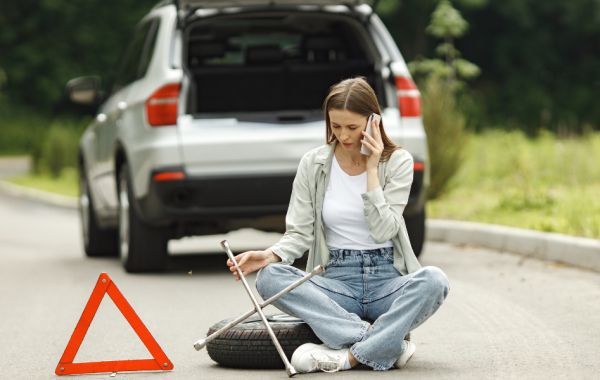Roadside emergencies such as flat tires or dead batteries, may be unpleasant and hazardous. If you want to safely get through these problems and get back on the road as soon as possible then you must call for roadside assistance.
What is Roadside Assistance?
Roadside assistance is a service provided to support drivers in the event of an accident or breakdown that is offered by insurance companies, automakers or other third-party suppliers. Roadside assistance may offer a number of services to get you going again or help organize a tow to the closest repair shop, no matter the reason for your breakdown whether you've run out of petrol, locked yourself out of your car or had some technical issue.

Types Of Roadside Assistance
Understanding the types of roadside assistance services available that can help you decide which one suits your needs. Roadside assistance services typically cover a wide range of emergency situations that including:
1. Towing Services
Towing services will take your vehicle to a local mechanic or the repair shop of your preference if it breaks down and cannot be fixed on the spot. Most roadside assistance plans contain a mileage restriction for towing, so be aware of this to avoid additional fees.
2. Battery Jump-Start Services
A dead battery is one of the most common reasons why drivers want roadside assistance. A roadside assistance professional can give you a rapid jump start to get back on the road, no matter whether you accidentally left your lights on or the battery just died from old age.
3. Winching
If your car is stuck in mud, snow or a ditch then roadside assistance can help pull it out.
4. Roadside Assistance Flat Tire
Another common problem for drivers is flat tires. Roadside help will send a specialist to replace your spare tire with the flat tire if you are unable to repair it yourself or do not have the necessary tools.
5. Lockout Services
It may be really annoying to lock yourself out of your car, especially if you're short for time. You may get back inside your automobile without causing any damage to it by using roadside assistance to unlock it.
6. Fuel Delivery Services
Even the most experienced drivers sometimes run out of petrol. Roadside help can provide you with enough fuel to go to the closest gas station so you can get back on the road as soon as possible.

How to Use Roadside Assistance in Emergency Situations Effectively
The procedure can go more smoothly if you take the following actions when you find yourself in need of roadside assistance in emergency situations:
- Stay Calm and Safe: Make sure you're safe first and foremost. Try to park your car in a place that is safe and away from traffic such as a parking lot or the shoulder of the road.
- Contact Your Roadside Assistance Provider: Contact your supplier using their mobile app or the phone number they have supplied. Prepare to provide the specifics of your car, your location and the nature of the problem.
- Provide Accurate Information: Giving precise information helps the dispatcher send the correct service. For example, let them know if you need a tow, fuel delivery, or a tire change.
- Wait for Assistance: Roadside assistance providers usually give you an estimated arrival time. If possible, remain in your vehicle until help arrives, especially if you're in an unsafe area.
- Know Your Limits: Some roadside assistance services are only available up to a certain distance, like towing up to 10 miles for free. Knowing your coverage limits can help you avoid unexpected charges.
What Happens When You Call Roadside Assistance
You may be asked some questions about your location, the problem and your car when you contact for assistance. When the technician arrives with the necessary equipment, be ready to supply as much information as you can. Response times might differ but depending on where you are, you can usually expect help in 30 to 60 minutes.

Best Roadside Assistance Plan
Plans for roadside assistance differ from one another. You have alternatives from the following, based on your needs:
- Vehicle Manufacturers: Free roadside assistance usually comes with new cars for a set period of time and is linked to the warranty.
- Insurance Providers: Some auto insurance policies offer roadside assistance as an add-on service. Check with them your insurance provider to see what they have got.
- Third-Party Providers: Services like AAA (American Automobile Association) offer independent roadside assistance, which can be used no matter what vehicle you drive.
The Cost of Roadside Assistance in Emergency Situations
The cost of roadside assistance for emergencies varies according on the provider and type of service needed. Usually, towing costs between $50 and $125 + $2 to $7 each mile. Lockout services, jump starts and flat tire replacements cost between $50 and $150. Delivery of gasoline costs $50 to $100, not including fuel. Roadside assistance is typically provided by insurance companies for $10–$30 per year but businesses like AAA charge $60–$120 per year for many services and distance traveled.
What to Have in Your Car?
It's always a good idea to be ready for emergencies on your own, even though roadside assistance may actually save lives. Keeping a few essentials in your automobile may have a significant impact:
- Spare tire and jack: If you’re able to change your tire, having these tools is crucial.
- Jumper cables: Even if you don’t need them, another driver might.
- First-aid kit: Always useful in case of an injury during an emergency.
- Flashlight: If your car breaks down at night, a flashlight will help you assess the situation or signal for help.
- Emergency contact numbers: Make sure you have your roadside assistance provider’s phone number saved, along with other emergency contacts.

Safety Tips While Waiting for Roadside Assistance
It may take some time to wait for roadside assistance that depending on the location and how easily accessible the service is. Here are some safety advices:
- Stay Inside the Vehicle: If you're on a busy road, staying inside your car is often the safest option.
- Turn on Your Hazard Lights: These lights help alert other drivers that your vehicle is stationary and that they should be cautious when passing.
- Use Reflective Triangles: If you have emergency triangles or flares, set them up behind your car to increase visibility.
- Be Aware of Your Surroundings: Avoid accepting help from strangers and wait for the professional roadside assistance to arrive.
Frequently Asked Questions (FAQs):
1. What is roadside assistance?
Roadside assistance is a service that helps drivers when their vehicle breaks down or encounters a problem on the road. It typically covers flat tires, battery issues, towing, fuel delivery, and lockouts.
2. When should I call roadside assistance?
You should call roadside assistance when you experience vehicle trouble that you cannot fix on your own, such as a dead battery, flat tire, or being locked out of your car.
3. How do I use roadside assistance in an emergency?
First, pull over to a safe location if possible. Then, contact your roadside assistance provider via their app, phone number, or online service. Provide details about your location and the nature of the emergency.
4. Is roadside assistance available 24/7?
Yes, most roadside assistance providers offer 24/7 support to help drivers in emergencies regardless of the time of day.
5. Does roadside assistance cover towing?
Yes, most roadside assistance plans include towing services to a repair shop or your home if the vehicle cannot be fixed on-site.
Conclusion
Roadside help may be a lifeline in an emergency situation, offering peace of mind and prompt aid. You can manage unforeseen automobile problems safely and effectively if you are aware of the specifics of your plan and know when to seek assistance. When the unexpected occurs, having a roadside assistance package will keep you protected either it's a flat tire, dead battery or little collision.








